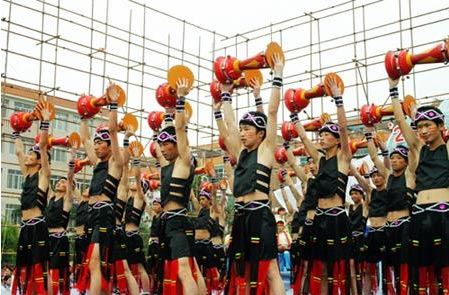The Zhuang Ethnic Minority
Updated: 2012-05-15 16:43
(chinaculture.org)
|
||||||||
The Zhuangs are polytheists, worshipping among other things giant rocks, old trees, high mountains, land, dragons, snakes, birds and ancestors. Taoism has also had a deep influence on the Zhuangs since the Tang Dynasty. In the old days, there were semi-professional Taoist priests in the countryside, and religious rites cost a lot of money. Foreign missionaries came to the area in the 19th and early 20th centuries, but their influence was limited to cities and towns.
Development After 1949
Land reforms began in the Zhuang area immediately after the founding of the People's Republic. Land was confiscated from evil landlords and distributed among the poor peasants. Later producers' cooperatives were formed while the socialist transformation of handicrafts and private industry and commerce was carried out.
Starting from 1952, the policy of regional ethnic autonomy was implemented in the area. At first, a Zhuang autonomous region was set up in the western part of Guangxi, which was enlarged to cover the whole of Guangxi and renamed the Guangxi Zhuang autonomous region in 1958. Shortly afterwards, the Wenshan Zhuang-Miao autonomous prefecture was established in Yunnan province and the Lianshan Zhuang-Yao autonomous county in Guangdong province. According to statistics tabulated in 1984, there were more than 207,208 Zhuang government employees at various levels in Guangxi, making up one-third of the total number in the region. The case in Wenshan Prefecture and Lianshan County was about the same.
The Zhuang area is basically agricultural, but before 1949 the local people never had enough to eat despite their hard work and the favorable natural conditions. By 1983, they had raised grain output by 158 per cent thanks to improved field management and the 500,000 water conservancy projects built since liberation.
Forestry in the Zhuang area has grown even more rapidly, with timber output 150 times what it was before 1949.

The rapid growth of agriculture and forestry has contributed to the development of modern industry, which started from scratch after liberation in 1949. In the early 1980s, Guangxi annually produced 4,400 tractors and 3,600 farm lorries.
In transportation, highways now reach every township in the region, railway mileage has almost quadrupled and shipping services have been opened on the main rivers.
Education and medical services have also taken on a new look. There were three colleges in Guangxi in the early 1950s but higher education was still beyond the reach of the ethnic groups because of their lack of elementary and secondary education. Today the autonomous region has over 20 universities and colleges, and the Guangxi Ethnic Institute alone has turned out over dozens of thousands minority graduates, half of whom were Zhuangs. Elementary and middle schools have increased in large numbers so as to enroll all school age children.
In the past, the Zhuangs had such a shortage of medical services that for generations they suffered from infectious or contagious diseases like cholera, smallpox, snail fever and malaria. The incidence of malaria, for example, exceeded 90 per cent. Now these diseases have almost been eliminated since hospitals cover all cities, counties and townships, and every village has its clinic.
Source: www.china.org.cn
Editor: Yang Yi

 'Taken 2' grabs movie box office crown
'Taken 2' grabs movie box office crown
 Rihanna's 'Diamonds' tops UK pop chart
Rihanna's 'Diamonds' tops UK pop chart
 Fans get look at vintage Rolling Stones
Fans get look at vintage Rolling Stones
 Celebrities attend Power of Women event
Celebrities attend Power of Women event
 Ang Lee breaks 'every rule' to make unlikely new Life of Pi film
Ang Lee breaks 'every rule' to make unlikely new Life of Pi film
 Rihanna almost thrown out of nightclub
Rihanna almost thrown out of nightclub
 'Dark Knight' wins weekend box office
'Dark Knight' wins weekend box office
 'Total Recall' stars gather in Beverly Hills
'Total Recall' stars gather in Beverly Hills
Most Viewed
Editor's Picks

|

|

|

|

|

|
Today's Top News
Health new priority for quake zone
Xi meets US top military officer
Japan's boats driven out of Diaoyu
China mulls online shopping legislation
Bird flu death toll rises to 22
Putin appoints new ambassador to China
Japanese ships blocked from Diaoyu Islands
Inspired by Guan, more Chinese pick up golf
US Weekly

|

|







